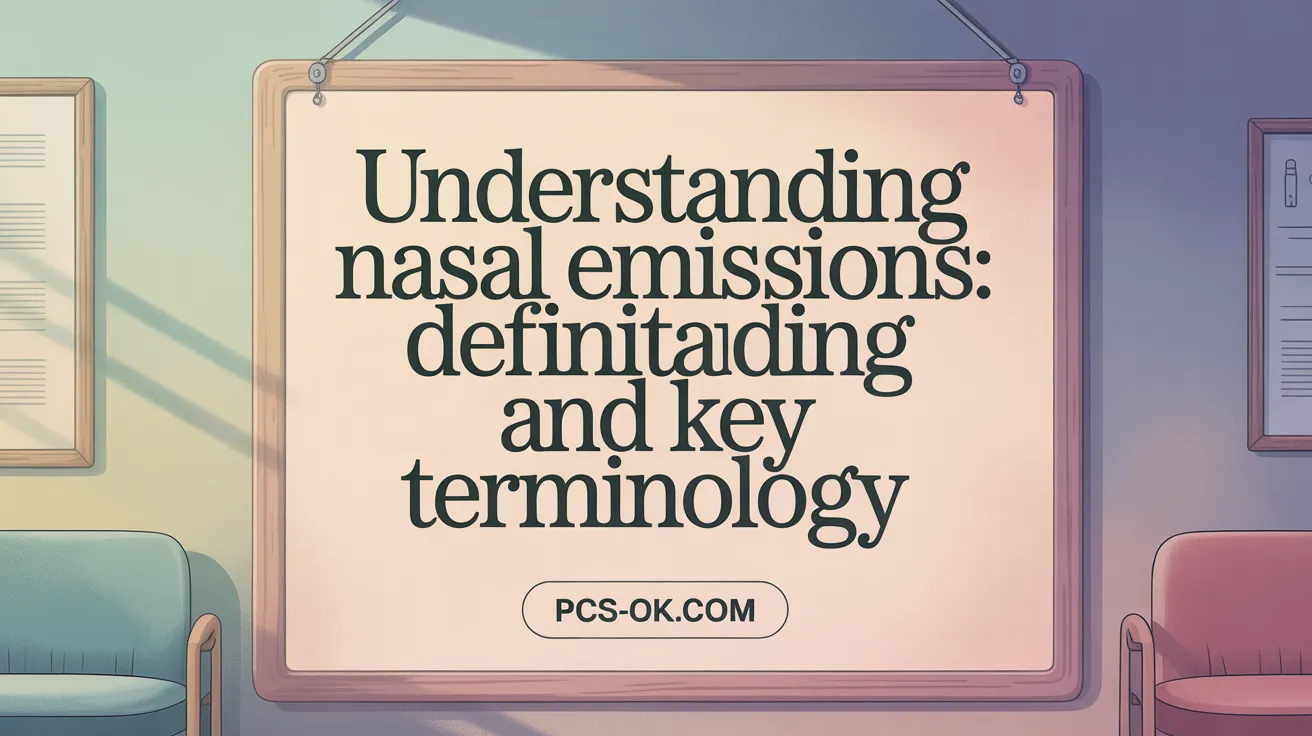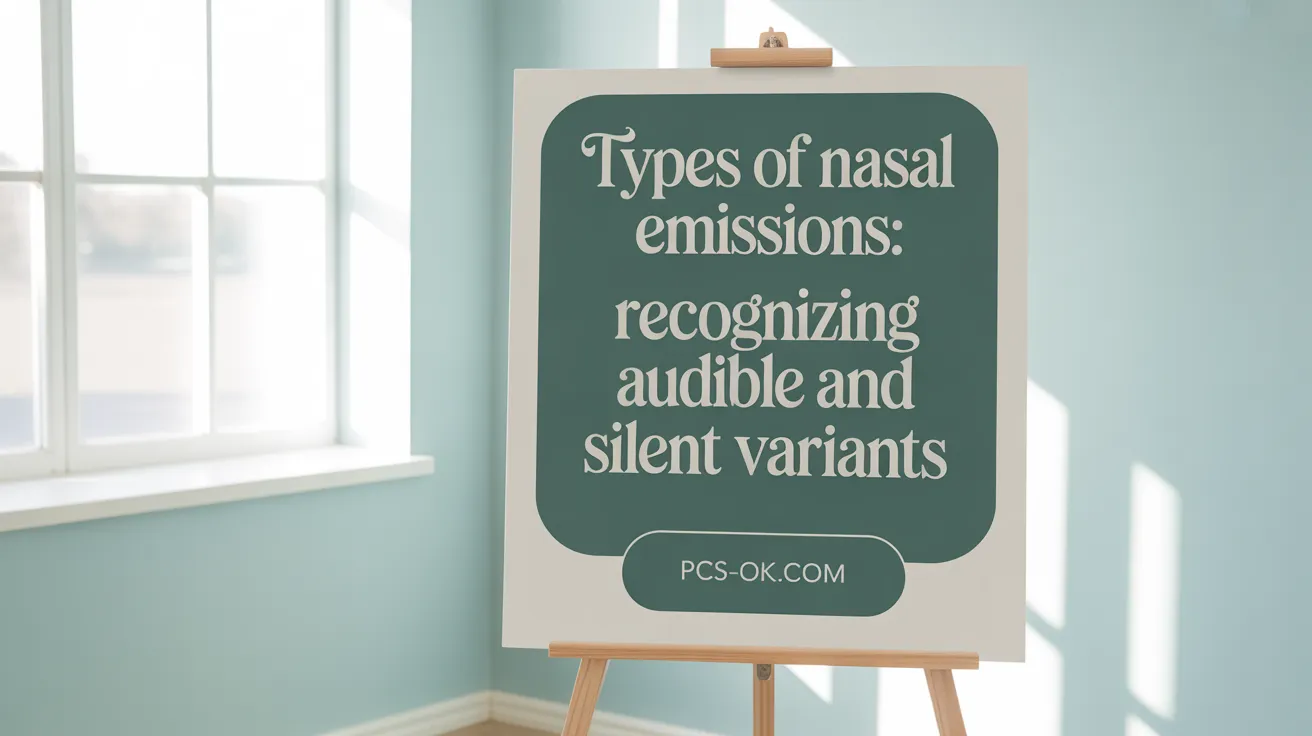Understanding Nasal Emissions in Children’s Speech
Setting the Stage: What Are Nasal Emissions in Children’s Speech?
Nasal emissions in children’s speech represent a complex phenomenon where air escapes through the nasal cavity during sounds that typically require oral airflow. This can affect the clarity and quality of a child’s speech and is often linked to structural or functional abnormalities in speech anatomy. Understanding the terminology, causes, and the implications of nasal emissions is essential for parents, educators, and clinicians alike to ensure timely and effective intervention.
Defining Nasal Emissions and Clarifying Terminology

What are nasal emissions in children’s speech, and what terminology is used to describe this phenomenon?
In children’s speech, nasal emissions refer to the abnormal escape of air through the nose during the production of certain consonant sounds, especially those that require high intraoral pressure like /p/, /t/, /k/, /s/. This airflow leakage often results from velopharyngeal insufficiency, where the soft palate does not fully close against the back of the throat, or from structural abnormalities such as a cleft palate.
Nasal emissions can be either audible or inaudible. When they are loud enough, they can create distinctive sounds akin to a snort or turbulence, sometimes described as nasal rustle or nasal turbulence. In contrast, some emissions are silent, with little to no perceptible sound, often masked by hypernasality.
Several terms are used to describe different types of nasal emissions, each highlighting specific qualities or mechanisms. Terms like nasal air emission and nasal turbulence are common, with others including nasal rustle, velar flutter, and posterior nasal fricative. These descriptions help clinicians identify the emission’s nature and underlying cause.
Phoneme-specific nasal emissions happen on particular sounds such as fricatives (/s/, /z/, /f/, /v/) and affricates (“ch,” “sh”). These emissions may form part of obligatory issues due to structural deficits or be learned behaviors, termed compensatory nasal emissions.
Understanding this terminology assists speech-language pathologists in diagnosing and designing effective treatment strategies, which may include speech therapy exercises, surgical procedures, or prosthetic devices. Precise classification based on terminology improves communication among professionals and enhances patient care.
Causes and Contributing Factors Behind Nasal Emissions

Nasal emissions in children primarily stem from velopharyngeal dysfunction (VPD), a condition where the velopharyngeal sphincter does not close properly during speech. This failure creates an opening through which air escapes into the nasal cavity, resulting in audible or even very loud nasal emissions. The main causes of VPD include structural anomalies such as cleft palate and submucous cleft palate. These structural issues hinder the soft palate’s ability to form an effective seal against the throat walls, allowing excess air to pass through the nose.
In addition to congenital structural abnormalities, neurological issues can also impair the muscles involved in velopharyngeal closure. Conditions like cerebral palsy, traumatic brain injury, or neuromuscular disorders weaken the muscles or affect their coordination, leading to velopharyngeal insufficiency. Surgery history, such as adenoidectomy or palate repair, may also contribute to or worsen VPD by removing tissue important for maintaining nasal closure, thus increasing the risk of nasal emissions.
Furthermore, learned speech patterns and maladaptive articulations can mimic or cause nasal emissions. Some children may develop compensatory behaviors, such as incorrect placement of the tongue or abnormal use of the pharynx, to produce speech sounds, which can result in nasal airflow during speech that is mistaken for structural VPD.
Assessment of nasal emissions includes examining the anatomy and functionality of the velopharyngeal mechanism. Techniques like videofluoroscopy or nasendoscopy are used to visualize the soft palate, pharyngeal walls, and their movement during speech. Identifying the precise cause—whether structural, neurologic, or behavioral—is crucial, as it guides appropriate treatment strategies. These could range from speech therapy exercises focusing on anterior oral placement, to surgical interventions aimed at repairing structural deficits or improving velopharyngeal closure.
Understanding the diverse factors contributing to nasal emissions helps clinicians develop targeted, effective treatment plans that can significantly improve speech clarity and reduce nasal airflow disruptions in affected children.
Types and Characteristics of Nasal Emissions and Resonance Disorders

What are the different types of nasal emissions, and how are they characterized?
Nasal emissions during speech are classified based on whether they can be heard or not and on their cause. Some emissions are audible, producing sounds like snorting or rustling, while others are inaudible, only detectable through observation or specialized tests.
Audible nasal emissions often present as turbulence, a rustling noise, or velar flutter. These include terms like nasal turbulence and velar flutter, which describe specific mechanisms of airflow disturbance. For example, nasal rustle sounds resemble a snorting noise caused by turbulent airflow passing through a small velopharyngeal (VP) gap, which can cause tissue vibration or mucous displacement.
In contrast, inaudible nasal emissions happen when a large VP opening causes minimal impedance to airflow, making the sound masked by hypernasality. This occurs because there’s relatively little turbulence or sound distortion, rendering the emission silent to the listener.
Nasal emissions are also categorized based on their origin: obligatory or compensatory. Obligatory emissions arise from structural abnormalities such as cleft palate or fistulae, which cause an incomplete velopharyngeal closure. These are present regardless of speech effort. Compensatory emissions, on the other hand, develop as maladaptive learned behaviors, often as a result of previous structural deficits and persistent articulation errors. These may involve substitutions like a pharyngeal sound replacing an oral consonant.
Understanding these distinctions is vital for determining the appropriate treatment approach. Structural issues typically require surgical or prosthetic solutions, while learned behaviors benefit from targeted speech therapy.
Overall, the characteristics of nasal emissions—whether loud and turbulent or masked and silent—provide important clues for clinicians diagnosing velopharyngeal function and planning effective interventions for affected individuals.
Diagnosis and Clinical Evaluation of Nasal Emissions
How can nasal emissions be diagnosed, and what evaluation methods are used by clinicians?
Diagnosing nasal emissions involves a thorough assessment combining perceptual, instrumental, and imaging techniques. Speech-language pathologists (SLPs) are typically the first to perform perceptual speech evaluations. They listen carefully for signs of hypernasality, nasal emission, and articulation errors, which often indicate velopharyngeal dysfunction. This perceptual analysis remains the gold standard because of the clinician’s expertise in identifying subtle speech cues.
To supplement perceptual findings, clinicians employ instrumental assessments. One common method is nasometry, which measures the ratio of nasal to oral airflow during speech to quantify nasal emissions. Fiberoptic nasoendoscopy, or nasendoscopy, involves inserting a thin, flexible camera into the nasal cavity to directly observe the soft palate’s movement and its contact with the posterior pharyngeal wall during speech.
Videofluoroscopy is another valuable tool, providing dynamic X-ray imaging of the oropharyngeal structures while the patient speaks. It often uses contrast agents to visualize the movement of the velum and pharyngeal walls, revealing the pattern of velopharyngeal closure.
Further anatomical assessment with imaging techniques such as cephalometric radiographs or MRI can provide detailed information about structural abnormalities like cleft palate or fistula presence.
In addition to these assessments, evaluation of resonance provides information to differentiate hypernasality from nasal air emission. Hypernasality involves excessive nasal sound resonance, whereas nasal emission signifies abnormal air escape during speech.
Ultimately, the most accurate diagnosis of nasal emissions and velopharyngeal function results from a multidisciplinary approach that includes speech assessment, imaging, and anatomical examinations. This comprehensive evaluation guides targeted treatment planning, whether surgical, prosthetic, or speech therapy-based.
Search query for further research: diagnosis of nasal emissions in children
Approximate word count: 200 words
Treatment and Therapy Strategies for Nasal Emissions in Children
What treatment options and therapeutic strategies are effective for addressing nasal emissions in children?
Addressing nasal emissions in children involves a variety of interventions tailored to the underlying cause. For structural issues like velopharyngeal insufficiency (VPI), surgical options such as palatal repair or pharyngeal flap surgery are often recommended to restore proper closure of the velopharyngeal port during speech.
In addition, prosthetic devices like speech bulbs and palatal lifts can be used to improve velopharyngeal function. These devices help to compensate for structural deficits by aiding in closure during speech, thereby reducing nasal air emission and hypernasality.
Speech therapy is a vital component, especially for learned misarticulations or compensatory behaviors. Techniques include using auditory feedback, practicing proper oral placement, and employing co-articulation exercises to correct abnormal articulation patterns.
Postoperative therapy remains crucial. After surgical intervention, speech therapy helps refine speech placement, diminish hypernasality, and address residual nasal emissions.
A multidisciplinary approach enhances treatment success. Collaboration among ENT specialists, craniofacial surgeons, and speech-language pathologists ensures comprehensive management tailored to each child’s specific needs.
The combination of these strategies often results in the most effective reduction of nasal emissions, improving speech intelligibility and quality of life.
Bringing It All Together: Supporting Clear Speech in Children
Understanding nasal emissions in children’s speech requires a comprehensive grasp of its definitions, causes, types, diagnostic procedures, and treatment pathways. These emissions arise principally from velopharyngeal dysfunction often linked to structural or neurological challenges. Early and accurate diagnosis, incorporating advanced imaging and perceptual evaluation, is critical to guide effective intervention. Treating nasal emissions demands a multidisciplinary approach, combining surgery, prosthetics, and tailored speech therapy to improve speech clarity and overall communication development. With ongoing research refining terminology and diagnostic tools, healthcare professionals are better equipped to support children affected by nasal emissions, helping them achieve clearer, more intelligible speech and healthier social interactions.
References
- Understanding Nasal Emission During Speech Production
- Nasal Emission Speech Therapy Activities and Ideas
- What is nasal air emission?
- Kids Health Info : Nasal speech
- Resonance Disorders – Speech
- Glossary – Nasal Emission
- Resonance Disorders
- Cleft Speech: Hypernasality and Nasal Emissions – Allison Fors
- Understanding Nasal Emission During Speech Production
